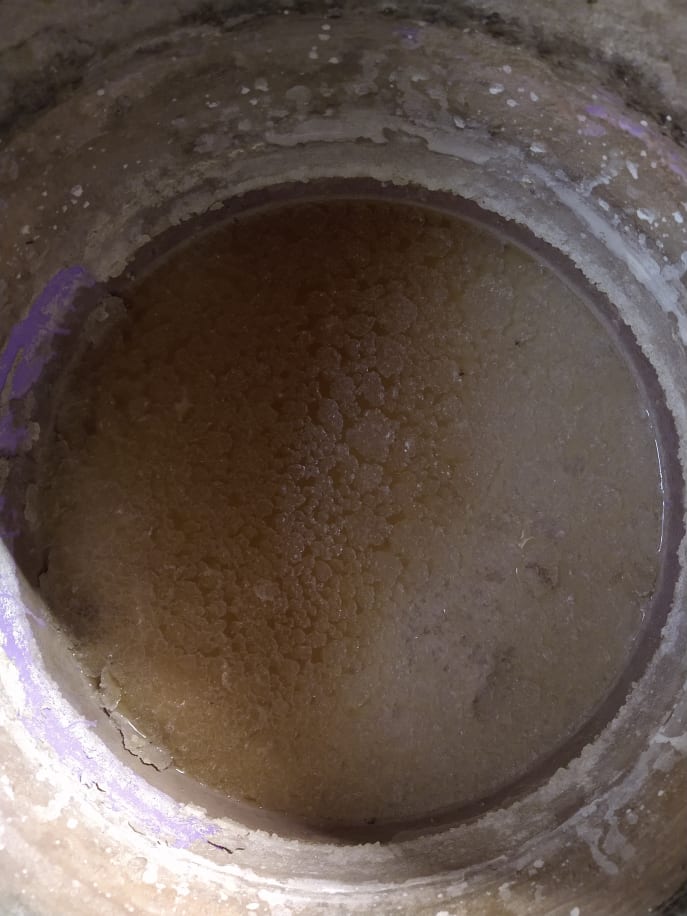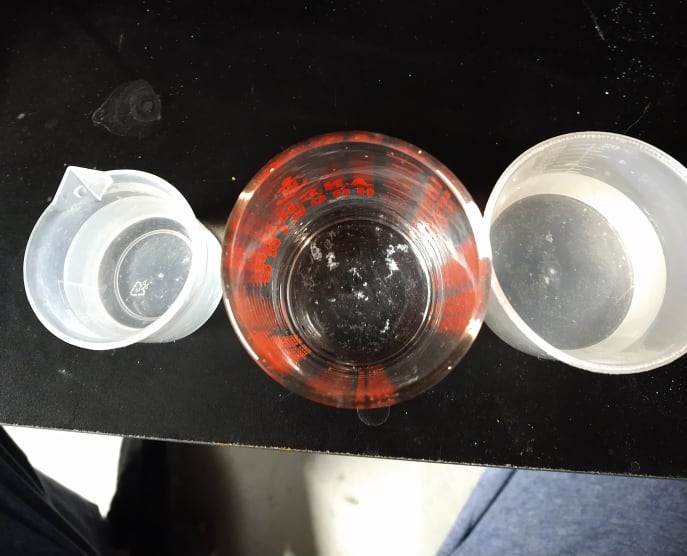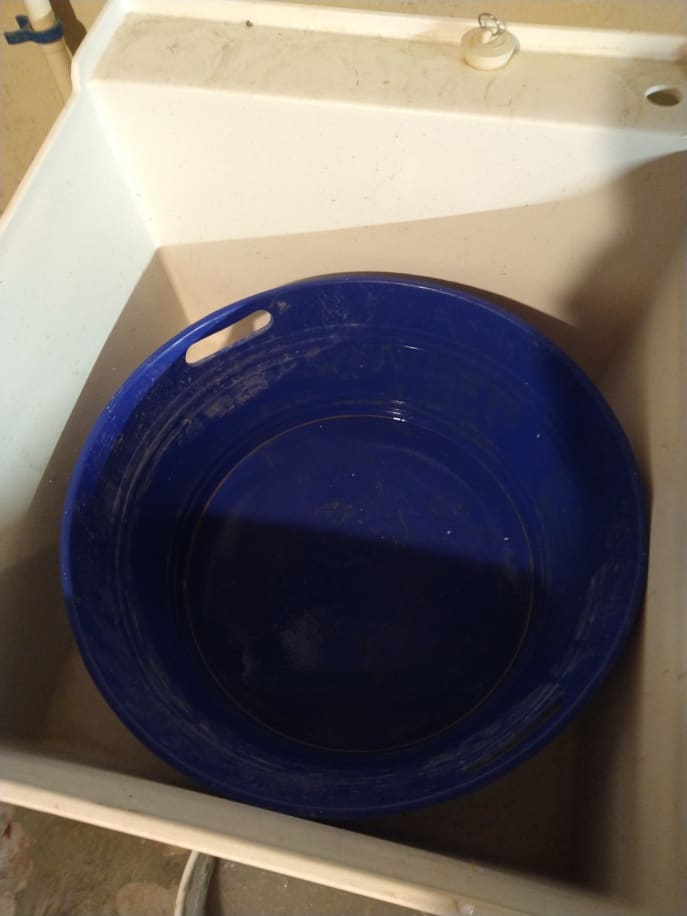gemfreak95
starting to spend too much on rocks
 
Member since February 2020
Posts: 127 
|
Post by gemfreak95 on Mar 18, 2024 20:57:09 GMT -5
This is my usual washout routine:   I dump my rocks into a colander over the purple bucket to collect the worst of the slurry, then move them to be rinsed in the sink. That drains into the other two buckets for settling, and when it's clear I pour, scoop, or siphon off as much clean water as I can into the floor drain. The grit-heavy leftovers go into the purple bucket to dry out, which is aided by the dehumidifier's vent blowing over it continuously. I've been waiting for the purple bucket to fully dry out so I can send the mud out with the trash. The other day I noticed an... unusual development. There are crystals forming on top of the remaining water.   I've never seen this before. They don't seem to have the right crystal habit to be salt, and have a more sweet scent than salty. I tried to dissolve one in pure water but nothing happened. The only thing I could figure is the fact I started adding borax to every batch. Do any more-experienced tumblers have any ideas as to what's going on here? If it is borax, can I skim the crystals off and reuse them? I'll also accept critiques on my waste management system. I usually have to take January and February off while the buckets dry out, so I could use some tips to speed the process up. Thanks! |
|
|
|
Post by Pat on Mar 18, 2024 23:40:45 GMT -5
Neat! Hope someone can help.
|
|
|
|
Post by southernlakehuronguy on Mar 19, 2024 7:35:21 GMT -5
My guess on the crystals is that it is calcium. Put a sprinkle of Epsom salt(magnesium sulfate) in a cup of water with your crystal and see if it dissolves. For your management of waste water, I bought a cheap aquarium canister filter, filled it with filter floss and run the water from the bucket through the filter after it has settled a few days.https://www.amazon.com/TechnToy-HW-603B-3-Stage-External-Canister/dp/B00CC6SCJQ
|
|
|
|
Post by chris1956 on Mar 19, 2024 11:59:51 GMT -5
I am assuming you aren't one of those people that uses sugar in their tumblers although I would think the sugar would stay dissolved.
I have two possible solutions to solids drying but they both take more space. One is get one or two more buckets. Then you can switch and let the others dry out. This is what I do and seems to work well. The other is get a shallow concrete mixing tub. I saw this on Michigan Rocks. You can get them from Lowes for about $18 for the bigger one. Basically it provides more surface area (more evaporation) so the mud will dry and and mud layer will not be as thick so it will crack much quicker. I would think the air has a better chance of getting to the mud since it is shallow compared to a bucket. But it probably takes up as much floor space as another two or so buckets.
|
|
|
|
Post by chris1956 on Mar 19, 2024 12:14:19 GMT -5
I think I also saw on a Michigan Rocks video (might have been the same one) that Rob Jugglerguy used something to settle the solids. I can't remember what it was (something from the kitchen) and can't find the video. Hopefully Rob will respond. Another thing that might work is adding alum. Same stuff you can buy at the grocery store for pickling. Not sure if this will work as I think it might depend on the pH. Might be expensive too if you can't find a larger container. But it won't take much if it works. Mixing of the alum is important (for contact with the particles) once you put it into the liquid or probably better to mix rapidly with some cloudy liquid in a smaller container first and then pour into bucket and gently mix for a short time. |
|
titaniumkid
has rocks in the head
  
Member since June 2023
Posts: 501
|
Post by titaniumkid on Mar 19, 2024 17:33:31 GMT -5
What rocks contributed to the slurry?
I would have thought they were borax crystals, but they should dissolve in water. Sugar crystals should dissolve in water too. Have you tried dissolving a small sample in something acidic like vinegar?
|
|
ThomasT
has rocks in the head
  
Member since June 2022
Posts: 616
|
Post by ThomasT on Mar 19, 2024 18:38:15 GMT -5
gemfreak95 What kind of lab did you say you're running there?  Interesting that the crystal is insoluble in water...
|
|
|
|
Post by Starguy on Mar 19, 2024 18:44:20 GMT -5
Neat. You can work on your washout from the toilet.
The crystals are cool. My guess is that the dehumidifier is causing something to be supersaturated in the solution. It’s probably the borax.
|
|
gemfreak95
starting to spend too much on rocks
 
Member since February 2020
Posts: 127 
|
Post by gemfreak95 on Mar 19, 2024 21:28:49 GMT -5
I set up a little experiment based on suggestions from southernlakehuronguy and titaniumkid .  All 3 cups got 40 ml of warm water and a crystal cluster about the size of the one in the tweezers. The beaker on the left for a pinch of Epsom salts, while the one on the right got about 20 ml of white vinegar. After 20 minutes or so the one in the epsom bath is gone, while the one in vinegar is almost dissolved. It's hard to tell if the control just broke up or is actually dissolving (they're very fragile). |
|
gemfreak95
starting to spend too much on rocks
 
Member since February 2020
Posts: 127 
|
Post by gemfreak95 on Mar 19, 2024 21:32:15 GMT -5
My guess on the crystals is that it is calcium. Put a sprinkle of Epsom salt(magnesium sulfate) in a cup of water with your crystal and see if it dissolves. For your management of waste water, I bought a cheap aquarium canister filter, filled it with filter floss and run the water from the bucket through the filter after it has settled a few days.https://www.amazon.com/TechnToy-HW-603B-3-Stage-External-Canister/dp/B00CC6SCJQ A cannister filter is an interesting idea, but I'm having trouble envisioning what you mean. Are you running the (mostly) settled water through it and out, or is it going back into the bucket? |
|
titaniumkid
has rocks in the head
  
Member since June 2023
Posts: 501
|
Post by titaniumkid on Mar 19, 2024 21:44:04 GMT -5
I set up a little experiment based on suggestions from southernlakehuronguy and titaniumkid .  All 3 cups got 40 ml of warm water and a crystal cluster about the size of the one in the tweezers. The beaker on the left for a pinch of Epsom salts, while the one on the right got about 20 ml of white vinegar. After 20 minutes or so the one in the epsom bath is gone, while the one in vinegar is almost dissolved. It's hard to tell if the control just broke up or is actually dissolving (they're very fragile). Nice! If it's now dissolving in warm water, I'm inclined to think borax (which would also explain the sweetness). Was the water you originally tried to dissolve it in cold? Temperature can affect solubility, though for it to not dissolve at all originally is still pretty strange. |
|
gemfreak95
starting to spend too much on rocks
 
Member since February 2020
Posts: 127 
|
Post by gemfreak95 on Mar 19, 2024 21:54:18 GMT -5
Nice! If it's now dissolving in warm water, I'm inclined to think borax (which would also explain the sweetness). Was the water you originally tried to dissolve it in cold? Temperature can affect solubility, though for it to not dissolve at all originally is still pretty strange. Yeah, I originally tried it in cold. I didn't set it up scientifically and wasn't watching it carefully, but it seemed like it did the same as the control: just breaking up if it did anything. |
|
titaniumkid
has rocks in the head
  
Member since June 2023
Posts: 501
|
Post by titaniumkid on Mar 19, 2024 22:00:20 GMT -5
Has the control dissolved now or is it just broken?
|
|
gemfreak95
starting to spend too much on rocks
 
Member since February 2020
Posts: 127 
|
Post by gemfreak95 on Mar 19, 2024 22:06:58 GMT -5
I am assuming you aren't one of those people that uses sugar in their tumblers although I would think the sugar would stay dissolved. I have two possible solutions to solids drying but they both take more space. One is get one or two more buckets. Then you can switch and let the others dry out. This is what I do and seems to work well. The other is get a shallow concrete mixing tub. I saw this on Michigan Rocks. You can get them from Lowes for about $18 for the bigger one. Basically it provides more surface area (more evaporation) so the mud will dry and and mud layer will not be as thick so it will crack much quicker. I would think the air has a better chance of getting to the mud since it is shallow compared to a bucket. But it probably takes up as much floor space as another two or so buckets. That's the first time I've heard of sugar in the tumbler, what's the point of that? As for the mixing tub, I do have this thing:  I think it's supposed to be a party ice bucket, I use it to "pan" my tumbles after rinsing. Do you think that'd work? I've considered speeding evaporation with a clamp lamp and a heat bulb, but something about that idea seems risky. |
|
gemfreak95
starting to spend too much on rocks
 
Member since February 2020
Posts: 127 
|
Post by gemfreak95 on Mar 19, 2024 22:15:39 GMT -5
Has the control dissolved now or is it just broken? Looks like it actually is dissolving. It's about where the one in the vinegar was an hour ago, one small crystal left. As to your earlier question, the mud is mostly from my last 2 batches: a feldspar mix and an agate-heavy mix of randoms. |
|
gemfreak95
starting to spend too much on rocks
 
Member since February 2020
Posts: 127 
|
Post by gemfreak95 on Mar 19, 2024 22:25:57 GMT -5
I think I also saw on a Michigan Rocks video (might have been the same one) that Rob Jugglerguy used something to settle the solids. I can't remember what it was (something from the kitchen) and can't find the video. Hopefully Rob will respond. Another thing that might work is adding alum. Same stuff you can buy at the grocery store for pickling. Not sure if this will work as I think it might depend on the pH. Might be expensive too if you can't find a larger container. But it won't take much if it works. Mixing of the alum is important (for contact with the particles) once you put it into the liquid or probably better to mix rapidly with some cloudy liquid in a smaller container first and then pour into bucket and gently mix for a short time. I tried using some pool flocculant to help it settle faster, and oh boy, that didn't help at all. I'll have to try that alum trick. |
|
titaniumkid
has rocks in the head
  
Member since June 2023
Posts: 501
|
Post by titaniumkid on Mar 19, 2024 22:33:19 GMT -5
The evidence seems to point to borax. The sweet scent, solubility in a weak acid and water (particularly warmer water), and amount that would have been present in the slurry make this more likely than any interesting compounds that may have been dissolved into the water during tumbling the rocks.
Actual chemists may now weigh in.
Thank you for answering my questions. This was fun.
I like your set up. Should have mentioned that earlier.
|
|
|
|
Post by southernlakehuronguy on Mar 20, 2024 7:24:18 GMT -5
My guess on the crystals is that it is calcium. Put a sprinkle of Epsom salt(magnesium sulfate) in a cup of water with your crystal and see if it dissolves. For your management of waste water, I bought a cheap aquarium canister filter, filled it with filter floss and run the water from the bucket through the filter after it has settled a few days.https://www.amazon.com/TechnToy-HW-603B-3-Stage-External-Canister/dp/B00CC6SCJQ A cannister filter is an interesting idea, but I'm having trouble envisioning what you mean. Are you running the (mostly) settled water through it and out, or is it going back into the bucket? I run the mostly settled water through the filter then into a 3" PVC pipe that is packed full of more filter floss that I have clamped to the inside of the utility tub. I capped the bottom of the 3" PVC and drilled drain holes about 2" from the bottom. On the crystals experiment, it was only a guess that it was calcium. I run a planted freshwater aquarium and learned to use Epsom salt to keep calcium in a dissolved state. The plants and snails use it for growth. One other thing, it was plaster of paris that jugglerguy used in his sludge bucket. |
|
|
|
Post by chris1956 on Mar 20, 2024 8:39:17 GMT -5
I am assuming you aren't one of those people that uses sugar in their tumblers although I would think the sugar would stay dissolved. I have two possible solutions to solids drying but they both take more space. One is get one or two more buckets. Then you can switch and let the others dry out. This is what I do and seems to work well. The other is get a shallow concrete mixing tub. I saw this on Michigan Rocks. You can get them from Lowes for about $18 for the bigger one. Basically it provides more surface area (more evaporation) so the mud will dry and and mud layer will not be as thick so it will crack much quicker. I would think the air has a better chance of getting to the mud since it is shallow compared to a bucket. But it probably takes up as much floor space as another two or so buckets. That's the first time I've heard of sugar in the tumbler, what's the point of that? As for the mixing tub, I do have this thing:  I think it's supposed to be a party ice bucket, I use it to "pan" my tumbles after rinsing. Do you think that'd work? I've considered speeding evaporation with a clamp lamp and a heat bulb, but something about that idea seems risky. I haven't used sugar myself, but there have been many posts from people that do on the forum. My understanding is that it is a quick and effective way to create a slurry to suspend the grit. If you think about doing this you might research it some more. I think there were some downsides to doing this also. Increased gas? Can't remember. Any kind of extra container would help. Increasing the surface area of the liquid to air will increase evaporation. A heat lamp would increase evaporation but always a risk with something like that plus, if you look at it long term, you could probably get a couple more buckets for the eventual cost of the electricity and blubs. |
|
|
|
Post by Jugglerguy on Mar 20, 2024 16:11:44 GMT -5
I think I also saw on a Michigan Rocks video (might have been the same one) that Rob Jugglerguy used something to settle the solids. I can't remember what it was (something from the kitchen) and can't find the video. Hopefully Rob will respond. Another thing that might work is adding alum. Same stuff you can buy at the grocery store for pickling. Not sure if this will work as I think it might depend on the pH. Might be expensive too if you can't find a larger container. But it won't take much if it works. Mixing of the alum is important (for contact with the particles) once you put it into the liquid or probably better to mix rapidly with some cloudy liquid in a smaller container first and then pour into bucket and gently mix for a short time. I have noticed that when I dump slurry from tumbling Petoskey stones (limestone) into my slurry bucket, it acts as a flocculant. But recently one of my YouTube viewers pointed out that plaster of Paris does the same thing. I've been using it in a salt shaker sort of thing, but bigger and with more holes. It's convenient to use and almost always settles the water overnight. Then I siphon off the clean water and dump it down the drain. I showed the shaker in my first livestream a few weeks ago, that might be what you remember. In response to showing it there, another viewer told me that epsom salts also do the same thing. I haven't tried that, but he seemed to prefer epsom salts. Here's a video where I showed my disposal method before I learned about plaster of Paris. |
|























